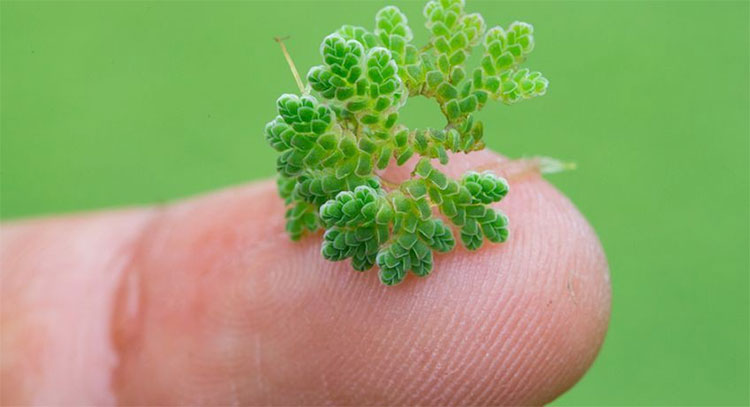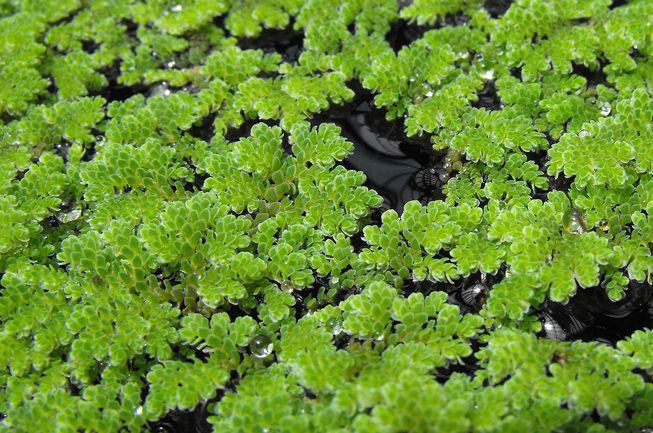Believe it: This small fern can help fight climate change
Recently, researchers from Duke University (USA) sequenced the genome of a green fern named Azolla filiculoides. But what does this mean?
A potential biofuel
Azolla filiculoides (A. filiculoides) are ferns that live under water. In particular, when conditions are favorable, they can grow quickly, even after a few months, the number from a stem can account for more than half of the lake regardless of area.

Tiny ferns are a great solution for climate change.
For water-based crops such as rice, this fern species is an excellent source of nutrition.
Azolla filiculoides are used as "green fertilizers" on rice fields in Asia for over 1,000 years. Because, this species has a close symbiotic relationship with Nostoc Azollae Cyanobacteria . They will "collaborate" together to absorb nitrogen from the air and convert it into a plant protein. Since then, we will not need to add much fertilizer to crops anymore.
Researcher Kathleen Pryer said: "Now we have the genome available for both ferns and Cyanobacterium, promising to exploit the secrets of this natural bio-fertilizer".
Research by Professor Fay-Wei Li, Boyce Thompson Cornell Institute, USA showed that the genome sequence helped ferns resist insects. It is like a "genetic gift" for ferns. Because most other plants lack the ability to avoid insects themselves.

The genome sequence helped ferns fight insects.
But not only that. Surviving on Earth for over 50 million years, it is estimated that this fern has absorbed about 10 trillion tons of CO 2 from the atmosphere. Thus, they contributed to "cooling" our planet in an extremely fast way.
So, it can be said, growing a large amount of this fern can help absorb CO2 and stop the process on Earth , especially with.
The sequencing of A. filiculoides' genome is a tough "battle" . This plant has quite "massive" genomes . Their genome contains 148 gigabases, equivalent to 148 million DNA character pairs (Nucleobases). Meanwhile, the human genome has only about 3 million base pairs.
For nearly 20 years, Pryer has tried to maintain the project of sequencing the genes of this fern species."In the process of mobilizing funding, I have encountered many different refusals. Something like" too different "," research is not important enough . " - she said.

The decoded genomes will be the "golden key" to make our planet greener.
However, with effort and passion, she was supported by the Beijing Institute of Genetics (China) to decode the genome completely for free. In particular, thanks to funding, researchers have also been able to decode the genome of Salvinia Cucullata, another famous fern.
"The sequence of genome sequencing is progressing well! Currently, we have about 10 different species of ferns during the sequencing process."
Hopefully, scientists will completely decode the genomes of these ferns. Perhaps, the decoded genomes will be the "golden key" to make our planet greener.
- Marching for climate change around the world
- Climate change 'challenges' in the Pacific region
- Climate change warms up the
- America helps Vietnam fight climate change
- This is how Dubai copes with climate change
- What is Climate Change?
- Science and technology 2014: Breaking small steps
- UN: dangerous climate change like war
- The terrifying change of the Earth due to climate change
- Cane can cool the earth
- SimCLIM helps build climate change scenarios
- Climate change is happening faster than expected
 Why do potatoes have eyes?
Why do potatoes have eyes? 'Tragedy' the world's largest carnivorous life: Death becomes ... public toilet
'Tragedy' the world's largest carnivorous life: Death becomes ... public toilet Tomatoes were once considered 'poisonous' for 200 years
Tomatoes were once considered 'poisonous' for 200 years Detecting microscopic parasites on human face
Detecting microscopic parasites on human face